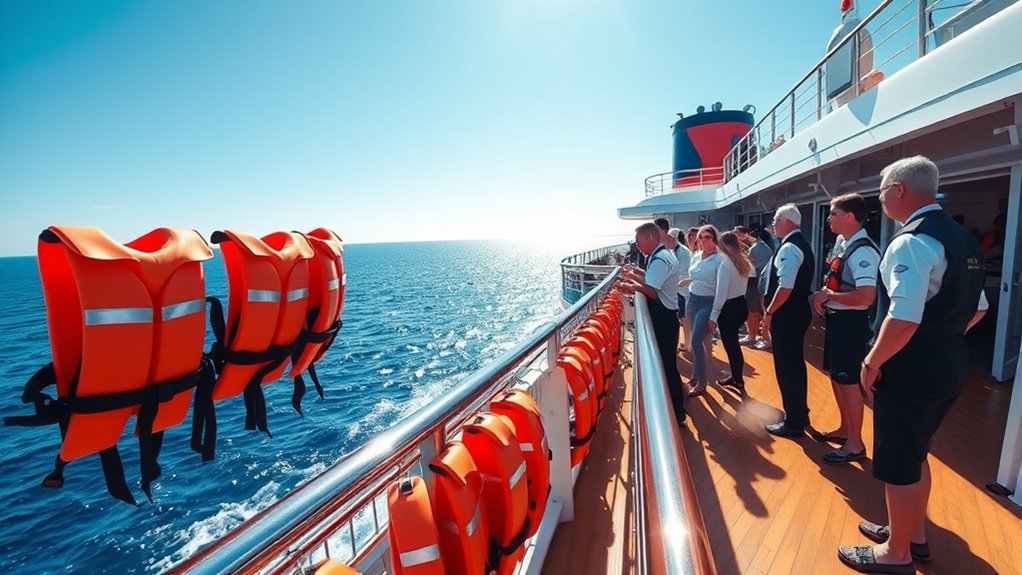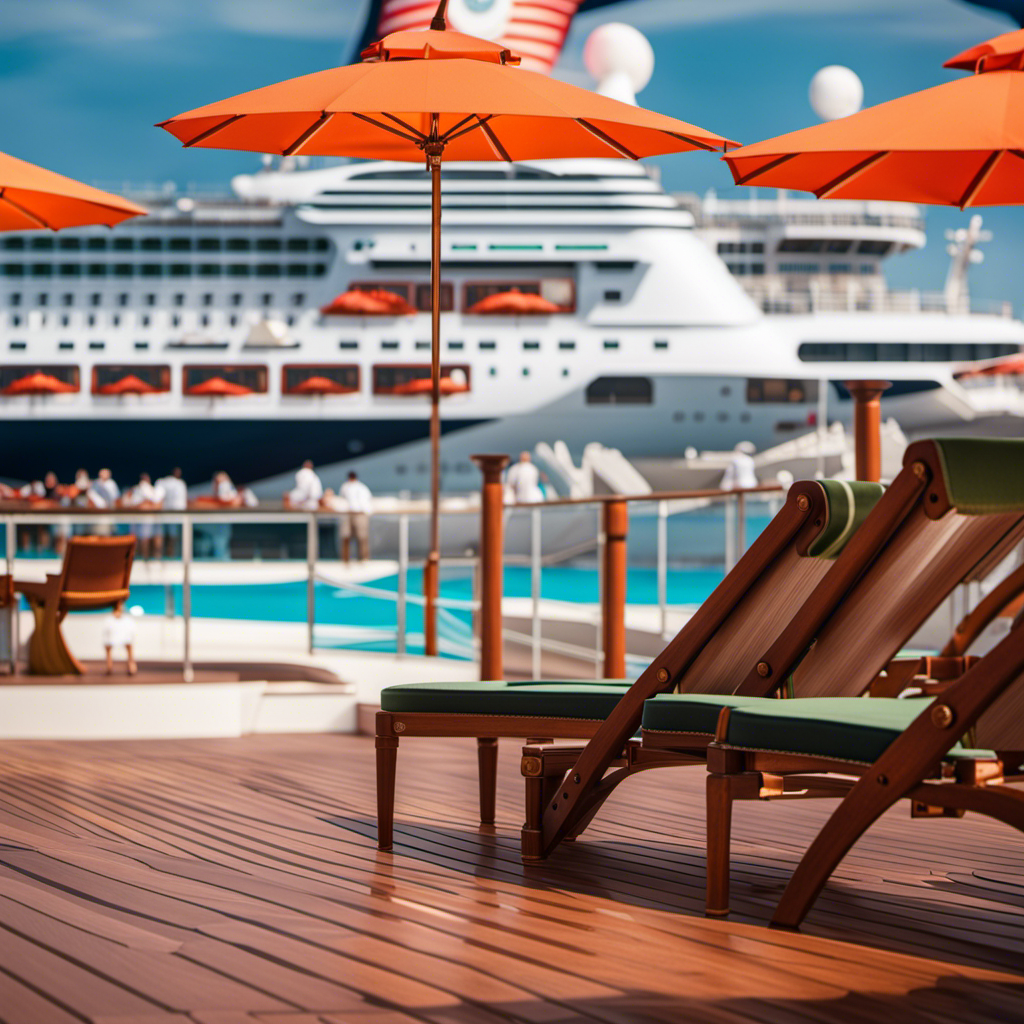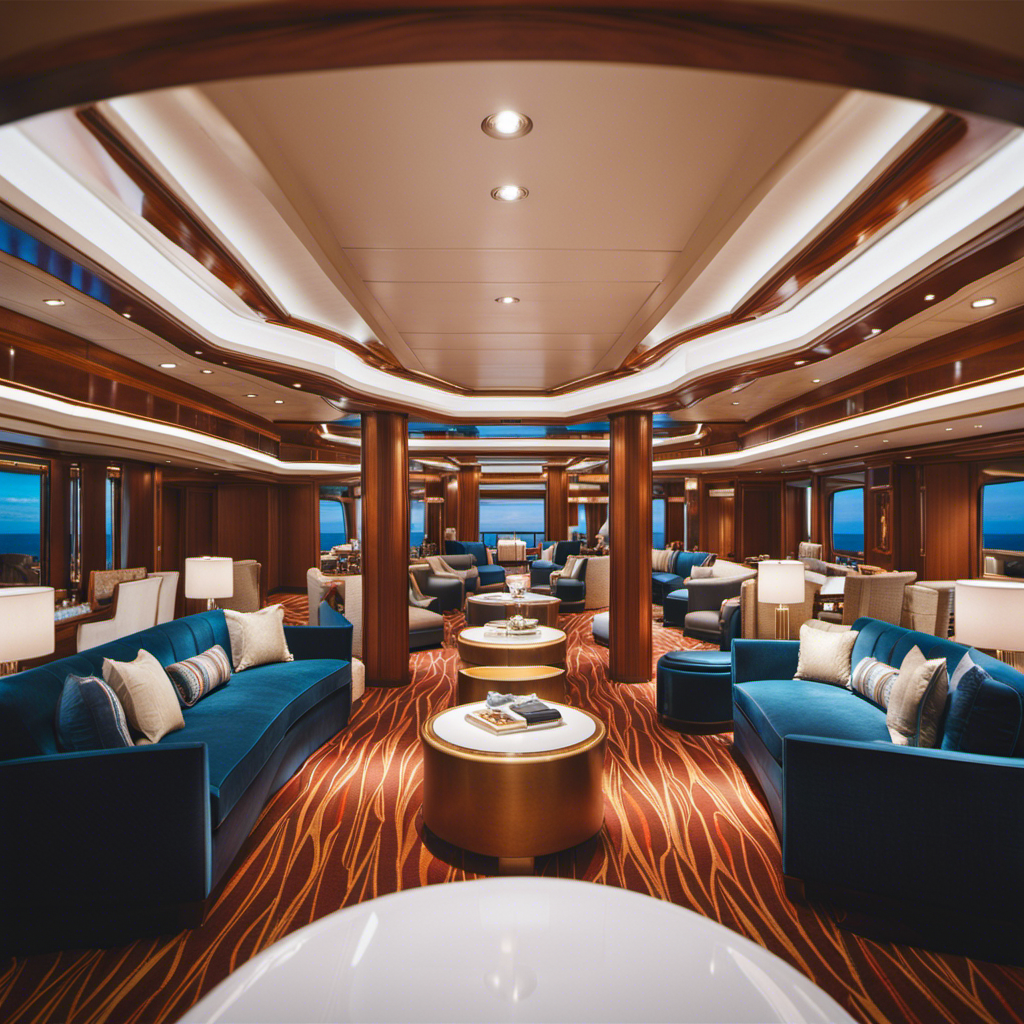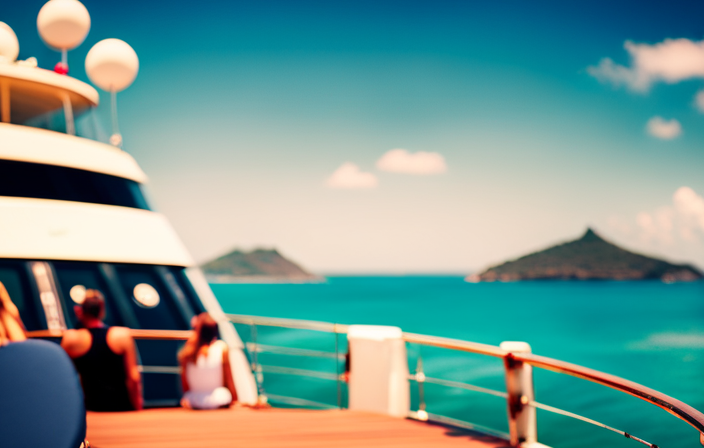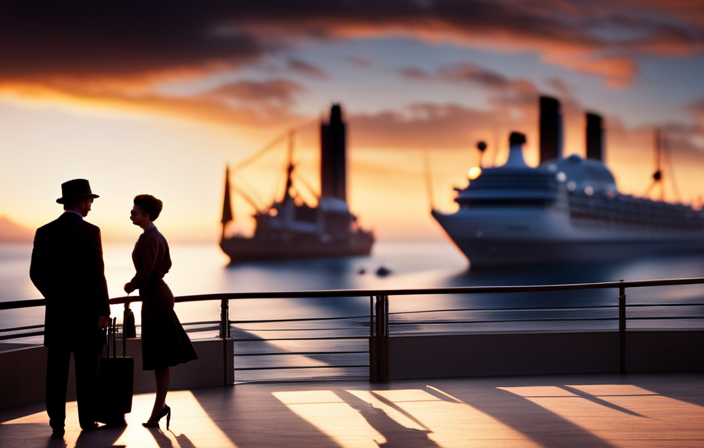To stay safe on a cruise ship, practice responsible alcohol consumption, keep your cabin secure, and build positive relationships with crew and fellow travelers. Pay close attention during safety briefings like the muster drill, always travel with a buddy, and stay alert in crowded areas. Be cautious with food and drinks, wear slip-resistant shoes, and know how to reach help quickly in emergencies. Continuing with these tips will help you navigate the cruise confidently and securely.
Key Takeaways
- Practice responsible alcohol consumption and stay aware of your personal limits.
- Keep your cabin secure by locking doors, storing valuables in the safe, and using door alarms.
- Attend safety briefings and familiarize yourself with emergency procedures, signals, and muster stations.
- Limit time in crowded areas, stay alert to surroundings, and report suspicious activity to crew immediately.
- Build positive relationships with crew and fellow travelers to enhance assistance and communication during emergencies.
Practice Responsible Alcohol Consumption
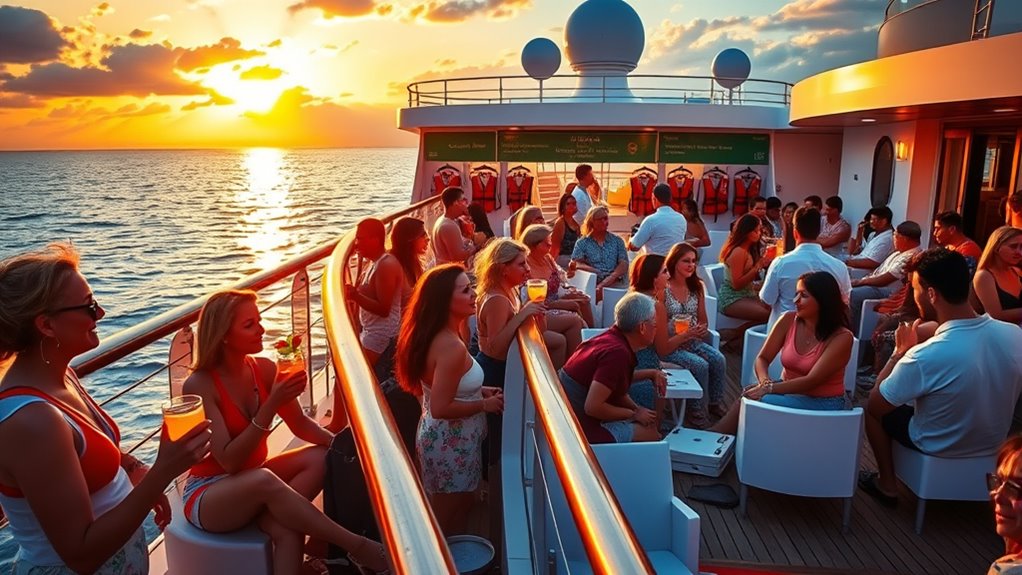
To stay safe on a cruise, it’s important to practice responsible alcohol consumption. Responsible drinking helps prevent accidents, injuries, and poor decision-making onboard. Keep in mind that overindulgence can lead to falls, conflicts, or making yourself vulnerable to theft or assault. Be aware of your personal alcohol limits and avoid accepting drinks from strangers. Remember, alcohol paired with hot weather or during shore excursions can cause dehydration and health issues, so stay hydrated. Many cruise lines offer beverage packages that might encourage excessive drinking, so monitor your intake to maintain alcohol safety. Staying mindful of your alcohol consumption ensures you enjoy your cruise without unnecessary risks, helping you stay safe and have a memorable trip.
Keep Your Cabin Secure and Use the Safe
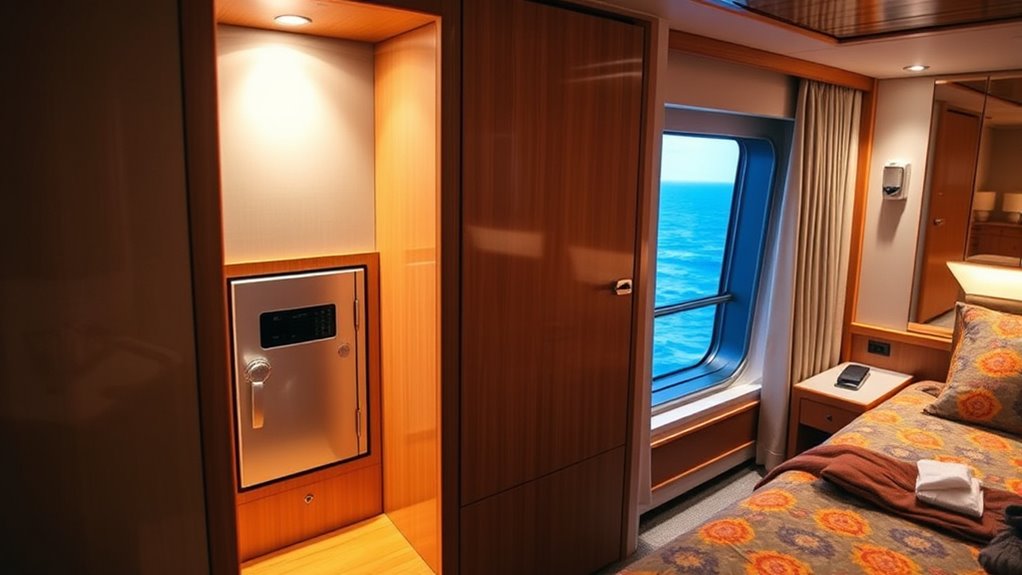
Keeping your cabin secure is essential for a worry-free cruise. Always keep your cabin door fully closed and locked when you leave or enter to prevent unauthorized access. Use the safe on a cruise to store valuables like jewelry, electronics, cash, and travel documents, keeping them out of sight. Consider requesting a door stopper with an alarm for added security while inside your cabin. Keep your cabin number private and avoid writing it in easily accessible areas to prevent strangers from locating your room. Before leaving your cabin or during port visits, make sure balcony doors are locked overnight and when unattended. These simple steps help ensure your cabin stays secure, giving you peace of mind so you can relax and enjoy your cruise. Additionally, utilizing security cameras can provide an extra layer of protection and peace of mind during your trip. Being aware of vetted security measures can further enhance your safety onboard. Remember that using proper safety protocols can significantly reduce risks and contribute to a safer voyage. Regularly reviewing the cruise line’s privacy policies can also help you stay informed about security practices and protections in place. Incorporating home decor security tips such as adding visual deterrents can further enhance your cabin safety.
Build Positive Relationships With Crew and Fellow Travelers
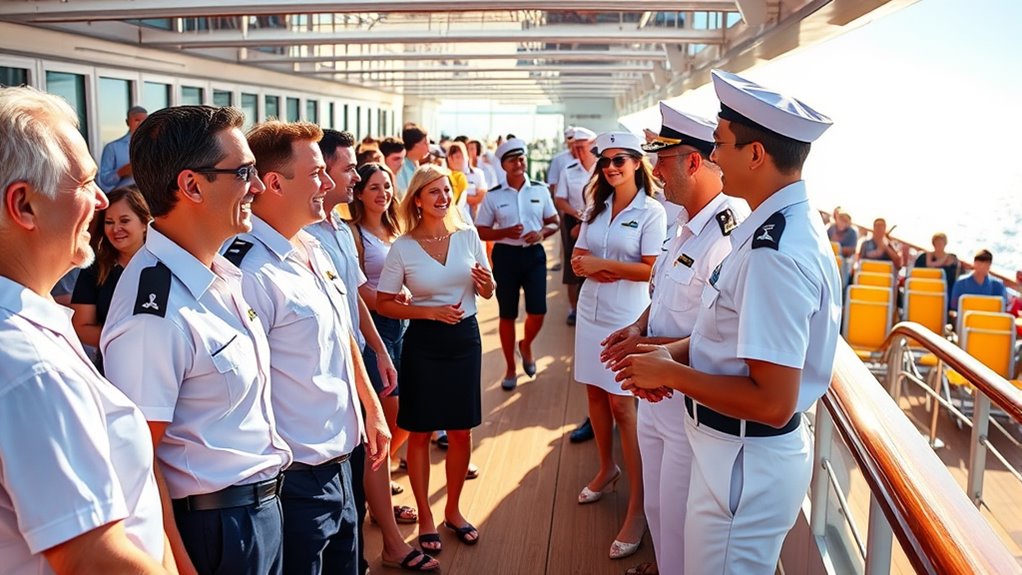
Establishing positive relationships with crew members and fellow travelers can considerably enhance your safety onboard. Building rapport through friendly communication helps crew recognize you and understand your needs, which can be crucial in emergencies. Introducing yourself to the cabin steward on arrival fosters trust and makes it easier to get assistance if needed. Maintaining open communication with fellow travelers and crew allows you to stay informed about safety protocols and potential hazards. Participating in organized activities or meet-ups encourages connections that boost your awareness and support network. A positive relationship with crew and peers not only makes your experience more enjoyable but also ensures they’re more likely to notice suspicious activity around your cabin or offer help in critical moments. Staying informed about best anime movies and animated films that touch hearts can also serve as conversation starters, helping you connect with others onboard. Developing an understanding of home theater projector features can also be a fun way to share interests and bond with fellow travelers who enjoy movies and entertainment. Additionally, familiarizing yourself with essential oils for relaxation or health support can provide common topics of discussion and shared experiences, fostering a sense of camaraderie among guests. Engaging with crew members about bicycle maintenance tips or safety measures can also be a helpful way to build rapport and learn useful skills that might come in handy during your trip. Moreover, knowing about family backgrounds and cultural heritage can facilitate meaningful conversations with fellow travelers, enriching your overall experience.
Pay Attention During the Muster Drill
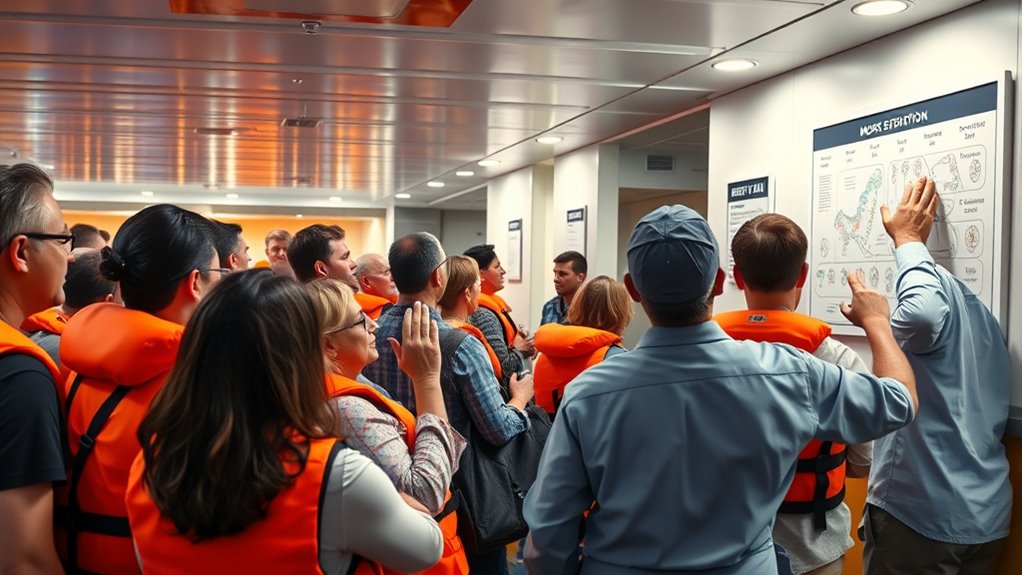
Make sure you pay close attention during the muster drill so you know your designated station and safety procedures. Focus on the instructions, signals, and how to properly wear your life jacket. Being alert and understanding these details can make a big difference in an emergency. Additionally, familiarizing yourself with the building and legal considerations of the cruise ship can help you better understand safety protocols and regulations. Understanding the importance of industry standards can also enhance your awareness of safety procedures onboard. Remember, the overall layout and design of the ship, including the bedroom areas, play a role in efficient evacuation and safety planning. Regular safety drills and awareness about cruise ship safety measures ensure everyone is prepared for unexpected situations. Being aware of regional safety regulations can further improve your preparedness during the voyage.
Know Your Muster Station
Attending the muster drill promptly before departure is essential because it helps you become familiar with emergency procedures and your designated muster station. Knowing your muster station is vital for safety on a cruise ship. Usually, the location is marked on your cabin door or in your safety information packet. During the drill, pay close attention to how to properly don your life jacket and the safety signals used on the ship. Memorize or note your muster station’s location, so you can find it quickly in an emergency. Understand the ship’s alarm sounds and what each signal means. Use this opportunity to ask crew members questions about safety procedures and escape routes, ensuring you’re prepared to respond swiftly and confidently if needed. Familiarizing yourself with the safety procedures can significantly improve your response time in an emergency. Additionally, being aware of emergency protocols helps ensure your safety and that of others onboard. It’s also helpful to review the ship’s evacuation plan beforehand to understand all possible routes and methods of escape. Knowing the ship layout can further assist you in navigating quickly during an emergency. Remember, proper preparation during the drill can make all the difference in a real emergency situation.
Understand Safety Procedures
Paying close attention during the muster drill is crucial because it guarantees you’re fully aware of the ship’s safety procedures. During the drill, focus on the safety instructions, alarms, and signals provided to understand emergency procedures. Knowing how to respond quickly can make all the difference in an emergency.
Here are key steps to follow:
- Locate your designated muster station and review the route.
- Practice how to properly don your life jacket.
- Pay attention to safety signage and instructions posted around the ship.
Avoid distractions like phones or conversations during the drill so you can absorb all necessary information. Being attentive ensures you’re prepared and confident should an emergency arise.
Always Travel With a Buddy
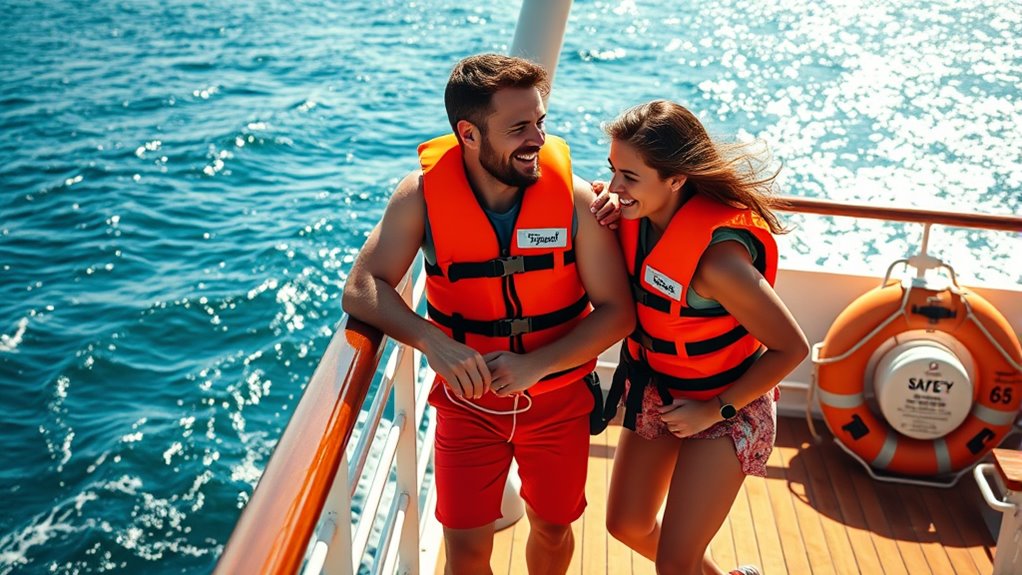
Traveling with a buddy keeps you safer by ensuring someone is there to help if emergencies happen. It also makes you less vulnerable to theft or assault, both onboard and onshore. Sharing your plans and staying connected helps prevent getting lost or stranded in unfamiliar places.
Share Your Travel Plans
Sharing your travel plans with a trusted friend or family member is essential for your safety on a cruise. When you share your plans, you guarantee someone knows your whereabouts, which is crucial for cruise safety. Use the buddy system by informing your travel partner of your itinerary and activities. This way, both of you can stay accountable and prepared. To maximize safety, follow these steps:
- Share your travel plans and scheduled activities with a trusted person before and during the cruise.
- Establish a check-in schedule with your buddy to confirm safety and whereabouts.
- When exploring ports alone, always inform your buddy of your departure time, destination, and expected return.
Implementing these tips keeps you connected and protected throughout your journey.
Stay Connected Throughout
Staying connected with a travel buddy is crucial for your safety throughout the cruise. The buddy system ensures you have someone to rely on in emergencies, whether onboard or during shore excursions. By maintaining clear communication, you can share your plans and whereabouts, reducing the risk of getting lost or facing danger alone. Having a buddy also helps deter suspicious behavior from others and provides mutual oversight during activities. If you’re ever ill or injured, your travel partner can quickly assist in seeking help or contacting the ship’s medical staff. Keeping in touch with your buddy throughout the trip enhances your overall safety and peace of mind. Remember, staying connected isn’t just about convenience; it’s a fundamental safety measure that keeps you protected at all times.
Manage Cash and Payment Methods Wisely
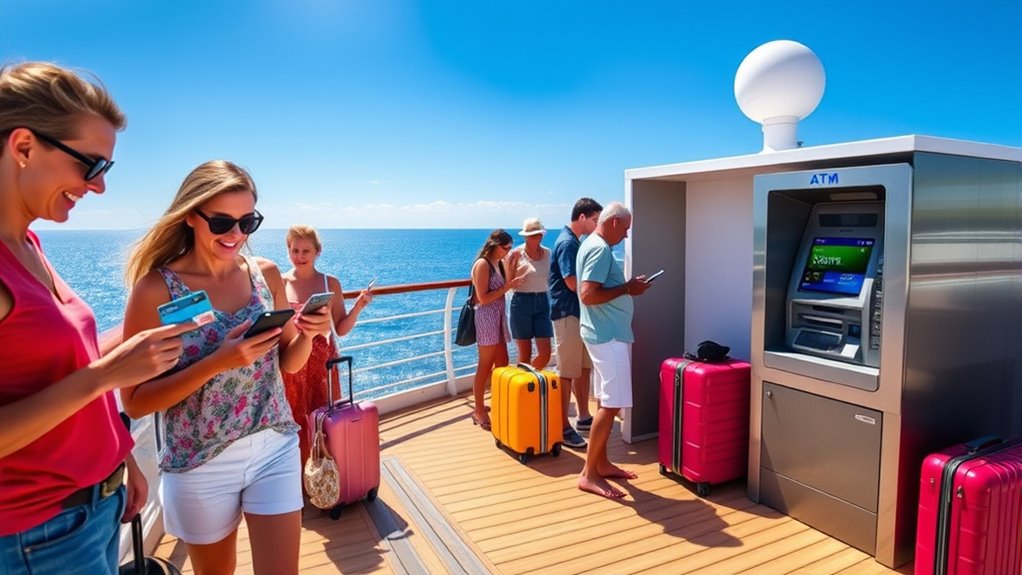
Managing your cash and payment methods carefully is essential to staying safe on a cruise. To protect your valuables and avoid theft, follow these tips:
- Use the cruise ship’s safe to store cash, credit cards, and important documents, and keep tempting items out of sight.
- Limit cash you carry ashore during port excursions, opting for the ship’s credit or debit card for purchases whenever possible.
- Carry only essential cash in a secure money belt or hidden pouch, and be discreet with your cash holdings, avoiding flashing large sums in public or crowded areas.
Stay Alert and Avoid Excessively Crowded Areas
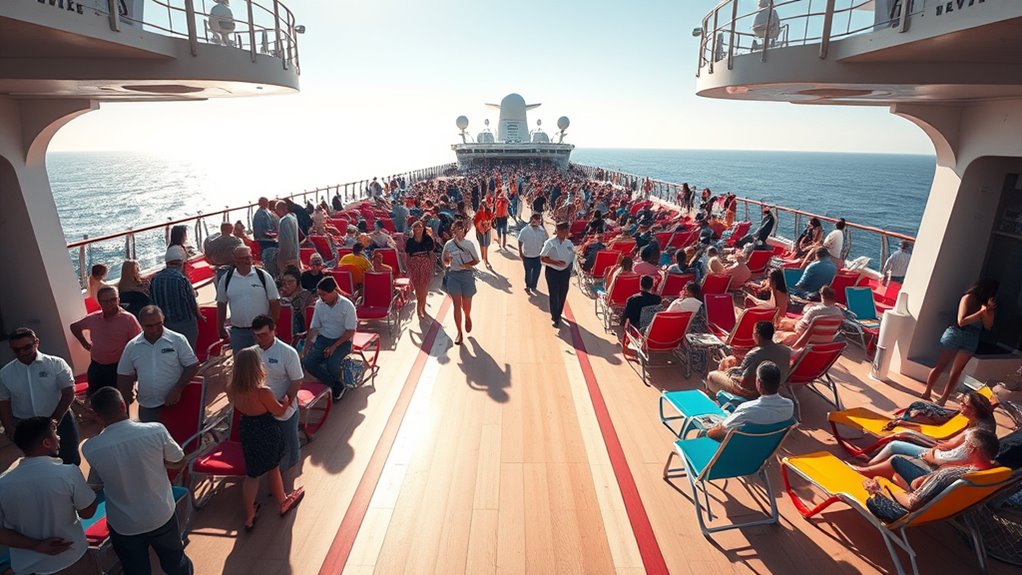
Being mindful of your surroundings is essential when on a cruise, especially in crowded areas. Large crowds in enclosed spaces can increase your exposure to infectious diseases and make emergency evacuations chaotic. Standing or sitting in densely packed zones heightens the risk of bumps, falls, or injuries, compromising your safety. To protect yourself, limit time spent in overly crowded areas and stay aware of your environment.
| Area Type | Risks | Safety Tips |
|---|---|---|
| Main Entrances | Congestion, confusion | Avoid during peak times |
| Entertainment Venues | Falls, accidents | Keep distance, stay alert |
| Pool Decks | Slips, crowding | Use caution, avoid pushing |
Be Cautious With Food and Beverage Choices
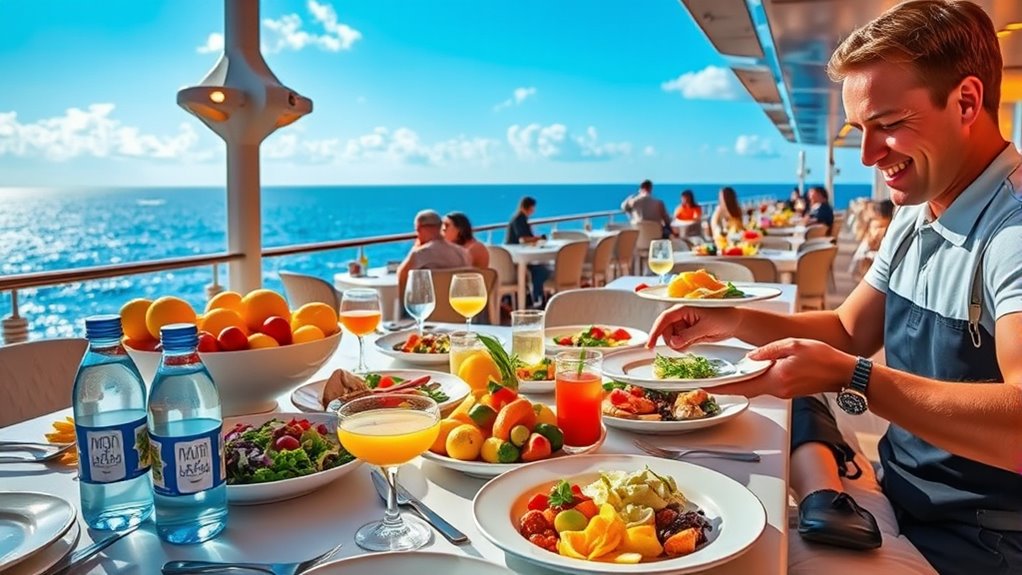
To stay healthy on a cruise, it’s important to be cautious with your food and beverage choices. Food safety is key to avoiding foodborne illnesses. Always verify that the food looks fresh and has been properly handled before eating. Use hand sanitizer before handling or eating food to reduce germs transfer. Be cautious with alcohol, as excessive drinking can impair judgment and increase health risks. Avoid eating from unlicensed vendors or suspicious buffets. Also, if a dish looks or smells off, discard it and notify the crew. Remember these tips to stay safe:
- Check for freshness and proper handling of food.
- Use hand sanitizer before eating.
- Avoid food from unverified sources and suspicious dishes.
Wear Non-Slip Footwear in Wet or Slick Areas
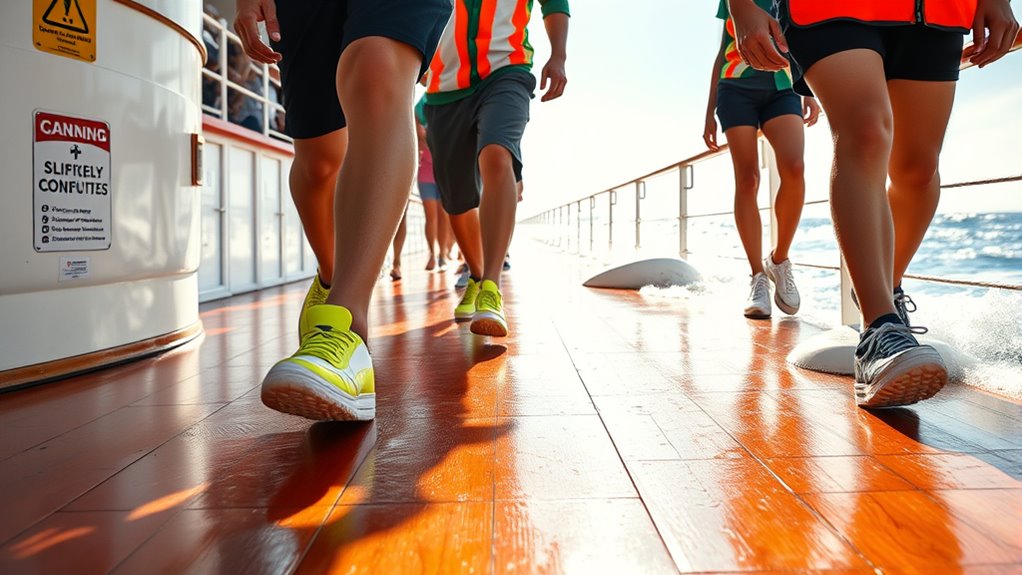
Wearing non-slip footwear is crucial for staying safe on a cruise ship, especially in wet or slick areas like decks, stairs, and poolside walkways. Proper shoes with non-slip soles reduce the chance of slips and falls, protecting passengers from injuries. Whether walking on wet decks, balconies, or outdoor walkways, good grip is indispensable. Regularly inspect your footwear for worn-out soles to ensure safety. Here’s a quick guide:
| Area | Recommended Footwear | Key Benefit |
|---|---|---|
| Wet decks | Non-slip shoes or sandals | Prevents slipping |
| Poolside walkways | Non-slip footwear | Improved grip in water zones |
| Stairs | Shoes with non-slip soles | Reduces trip hazards |
Choose footwear wisely to stay safe and enjoy your cruise fully.
Know How to Seek Help and Respond in Emergencies
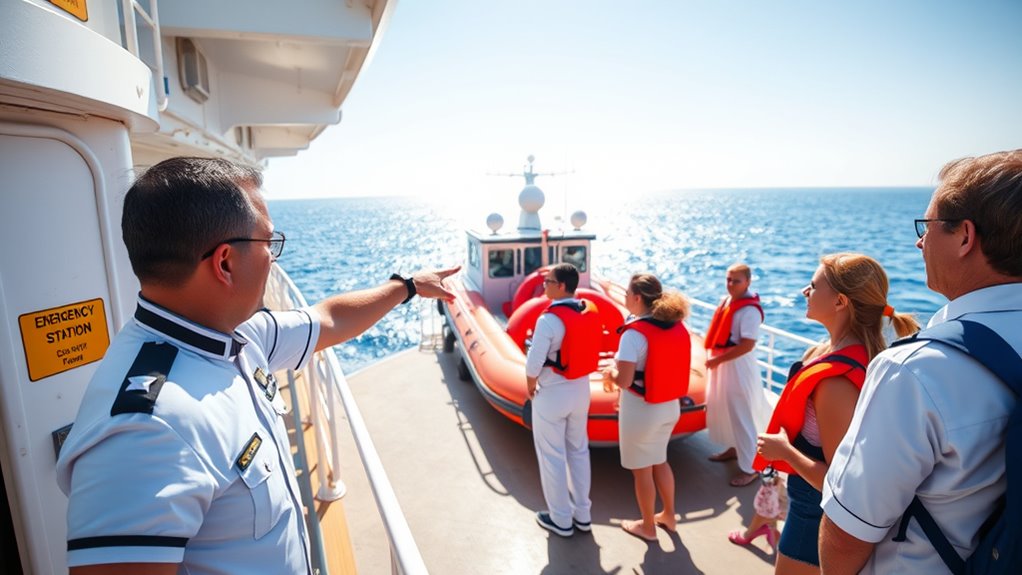
Knowing how to recognize emergency signals and locate safety equipment can save lives if an incident occurs. Quickly contacting crew members or visiting the infirmary guarantees you get help fast. Being prepared to respond confidently makes all the difference during an emergency on the ship.
Recognize Emergency Signals
Have you ever wondered how to quickly recognize an emergency on a cruise ship? Knowing the emergency signals can save lives. Pay attention to these key indicators:
- The continuous ringing of the general alarm, signaling you to prepare for action.
- Specific whistle patterns used during safety drills or real emergencies.
- Crew announcements and visual signals that provide crucial instructions.
Familiarize yourself with these signals so you can respond swiftly. During safety drills, you’ll learn how to reach your muster station promptly. Recognizing emergency signals ensures you’re prepared to seek help or follow instructions immediately. Always stay alert for these cues, and remember to carry your muster station card or ID so you can quickly identify your designated area during an emergency.
Locate Safety Equipment
Being able to quickly find and use safety equipment is essential in an emergency. Before departure, locate your muster station and familiarize yourself with the nearby life jackets. Know how to don them swiftly if needed. Throughout the ship, identify the locations of emergency exits, fire extinguishers, and alarm panels. Pay close attention during safety drills, so you understand the signals and procedures for evacuation or other emergencies. Keep a list of emergency contact numbers and the ship’s infirmary handy, so help is always within reach. Also, learn how to communicate with crew members or activate onboard emergency systems if you require assistance. By knowing where all safety equipment is and how to access it, you’ll be better prepared to respond confidently and swiftly in a crisis.
Contact Crew Quickly
How can you quickly get help from the crew in an emergency? Knowing how to seek emergency assistance is vital. First, familiarize yourself with the ship’s emergency call buttons and cabin phone systems. These are your fastest way to alert crew members. Second, locate the nearest crew station or infirmary, and keep their contact info accessible. Third, always follow crew instructions carefully during emergencies, as they’re trained to guide you effectively.
- Use emergency call buttons or cabin phones to report incidents immediately.
- Know the location of muster stations and emergency signals from safety briefings.
- Alert crew about suspicious activity or safety concerns by following their instructions.
Staying calm and promptly following these steps ensures you get quick help and keep everyone safe.
Frequently Asked Questions
How to Protect Yourself on a Cruise?
To safeguard yourself on a cruise, always travel with a buddy and avoid isolated areas or late-night walks alone. Limit alcohol so you stay alert and aware of your surroundings. Keep your cabin door fully closed and locked, using the safe for valuables. Don’t accept drinks or invites from strangers, and stick to organized shore excursions. Staying cautious and aware helps ensure a safe and enjoyable cruise experience.
What Is the Secret Code on a Cruise Ship?
Think of the “secret code” on a cruise ship like a hidden treasure map—you won’t find a secret code, but clear instructions are your compass. During safety briefings, crew members explain alarms and signals, just like legends on a map. Instead of searching for secret codes, pay attention to safety cards and announcements. Following these guidelines guarantees your journey stays safe, much like trusting a map keeps you on course.
How Safe Is Being on a Cruise Ship?
You’re generally safe on a cruise ship because of strict safety protocols and modern equipment like lifeboats and fire systems. While risks like falls or infections exist, they’re rare and preventable if you follow safety instructions and stay vigilant. Most incidents happen when passengers ignore guidelines or act recklessly. By exercising caution, paying attention to safety drills, and using common sense, you can enjoy your cruise with minimal risk.
Are There Armed Guards on Cruise Ships?
Did you know most cruise ships don’t have armed guards onboard? Security mainly relies on trained staff, surveillance, and controlled access points to keep you safe. While some ships or ports might have armed personnel for special situations, it’s rare. You should focus on following crew instructions and staying aware of your surroundings, as these measures are designed to prevent issues before they escalate, ensuring your safety during the voyage.
Conclusion
Staying safe on a cruise is all about being mindful and prepared. Did you know that over 60% of cruise accidents involve slips and falls? By following these tips, like wearing non-slip shoes and staying alert, you can reduce your risk and enjoy your trip worry-free. Remember, building good relationships with crew and fellow travelers also helps create a safer environment. So, stay vigilant, have fun, and make your cruise a memorable adventure for all the right reasons.

